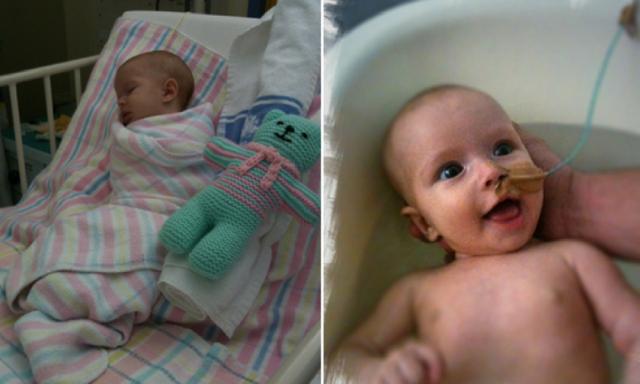Four-year-old Amedee is the “happiest, cheekiest, funniest little girl” according to her mum, Sarah Stacker. But life hasn’t always been like this.
As a newborn, Amedee was initially very unsettled, but being Sarah’s first baby, she didn’t know what constituted ‘normal’ behaviour.

Silent reflux in babies: Amedee at three months – sleeping upright in the hospital to stop her refluxing, and being tube fed. | Image source: The Nursery Collective.
Silent reflux in babies: “It was like being in a boxing match”
In an interview with The Nursery Collective, Sarah likened those early months to being in a boxing match.
“Imagine not being a boxer and not knowing how to defend yourself,” she said.
“Taking hit after hit after hit with no one able to rescue you, and no bell at the end of the round so you don’t know when it’s going end.
“You might get a reprieve for a day and you latch onto the thought ‘maybe things are changing’, ‘maybe she’s growing out of it’ (which is what all the doctors kept saying) until the crying, the screaming, the not sleeping and the pulling off the breast return – and just keep coming.”
Sarah describes many low points in the first few months with baby Amedee: “The breast aversion and the battle of every breastfeed, the failure to thrive, the screaming like she was being stabbed, the short 30-minute bursts of sleep during the day and hourly at night, the hours I would spend trying to get her back to sleep to have her wake at the slightest noise (like my knee creaking!) and have to start the whole process again.”
The new mum was also experiencing postnatal depression, adding to the already intense load that weighed heavily on her shoulders.

Sarah and Amedee, at one month, then at four years old. | Image source: The Nursery Collective.
Bravely, she says she felt as though she “really didn’t want this baby,” and thought to herself, “this was not what I signed up for.”
“The feeling that everything I was doing was wrong and wasn’t helping my baby, the not knowing where to turn to find the help I needed … and the list goes on. All of that when I was severely sleep deprived almost broke me.”
Along came an answer, but the battle wasn’t over
One day, a child health nurse suggested Amedee may have silent reflux, but warned Sarah she may have trouble getting the medical profession to take her concerns seriously.
“Each week at our weigh in she would send me to the GP,” said Sarah, “but I wasn’t allowed to say the child health nurse thought it was reflux.”
After three months of referrals to the GP and still no answers, Amedee was eventually diagnosed with silent reflux and failure to thrive. She was referred to a paediatrician who was hesitant to prescribe medication on the assumption that she would eventually outgrow it.
But Sarah wouldn’t give up, and her insistence paid off and Amedee was prescribed reflux medication and admitted to hospital for tube feeding .
Still, Sarah refers to this period as “just the beginning of our reflux hell hole.”
Even at hospital, Sarah had to continue to advocate for her baby. She says the head of Gastroenterology at the children’s hospital kept telling her that there was nothing wrong unless Amedee began projectile vomiting or bringing up blood, yet she still persisted.
“I had to threaten another specialist to leave Amedee at the hospital if I was not given a repeat prescription of stronger reflux medication upon discharge,” said Sarah.
“It was all so disheartening, but I kept pushing and through talking to people you find little snippets of info of things that can help and people who do know how to treat it – eg dairy and soy can trigger reflux so try removing them from your diet.”
Sarah finally found what worked for her and Amedee
When Amedee was around two years old, Sarah enlisted the help of a biomedical doctor to work on the cause of the problem rather than treating the symptoms.
“I have learnt so much about how our digestive system works and why reflux occurs in the first place and the things you can do to help stop it,” she said.

Sarah finally found what worked. | Image source: The Nursery Collective.
While Amedee has come a long way in the last few years, she still has the odd setback.
“She still battles with constipation which can lead to reflux, (think of it this way, if there is nowhere for the food in her stomach to go because she is clogged up, there is only one way to go – back up),” Sarah explained.
“A change in diet or too many starchy foods can clog her up, and we saw her most terrible bout of reflux in about two years when she started preschool this year.”
About silent reflux
According to the Reflux Infants Support Association, Silent Reflux is “refluxed material that flows back into the oesophagus, but isn’t forced out of the mouth.”
The infant or child may swallow it back down, or it may not travel far enough up the oesophagus to be swallowed. It can be more harmful than reflux as the stomach acids often remain in the oesophagus rather than being vomited out, potentially causing damage internally.
Silent reflux can often be difficult to diagnose as the signs are not as obvious as vomiting and some babies may continue to gain weight if they are comfort feeders who feed through the pain.
The Reflux Infants Support Association compiled some points to remember about silent reflux:
- Not all children suffering from reflux actually vomit; some may have what is termed ‘silent’ reflux – where the stomach contents only come part way up the oesophagus. Any form of reflux may disturb the child and cause problems.
- Parents may notice any of the other signs of reflux apart from the obvious one – vomiting/regurgitation. They may hear the baby or child reflux, or see them swallow repeatedly, and see no evidence of it.
- Some children can have silent reflux that presents with asthma or ear, nose and throat issues, with no obvious signs of reflux e.g. regurgitation.
Sarah’s advice to other mums
Having been through hell and back over a long period of time with Amedee’s pain and screaming, Sarah encourages others in a similar situation to not give up.
“Keep pushing and advocating for your child. Find people who have come out the other end and ask them what they did. Ask which medical professionals were able to help and go see them.”
This is Sarah Stacker’s story, as told to The Nursery Collective’s Cathy Nelson-Williams. You can follow them on Facebook or Instagram.
This article was first published on KidSpot and republished on theAsianparent with permission.
Lead image source from The Nursery Collective.
ALSO READ:
All About Silent Reflux in Babies: a Concise Guide for Parents
